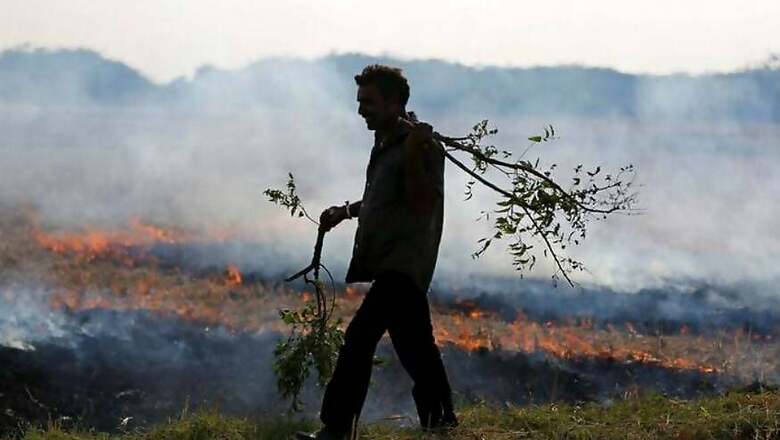
views
The Union Budget announced a subsidy plan to address crop residue management and deal with paddy stubble burning in north India.
The money will likely be spent on setting up straw-based fodder banks, and implementing technical interventions such as in-situ composting and the 'Happy Seeder’, a mechanical attachment to tractors that enables wheat sowing without the need to first rid the field of paddy straw.
Central intervention on this burning issue is long overdue. However, it is time that the government recognised that stubble burning in northern India is yet another symptom of a larger ecological catastrophe brewing in the region, an outcome of decades of misguided policy incentives and the entrenched lobbies that these have created.
These policies go back to the mid-1960s, when the government implemented a series of reforms to give a fillip to agricultural production and to modernise farming practices.
The introduction of input subsidies and Minimum Support Prices (MSP) for inducing the adoption of new technologies and HYVs (high-yielding varieties) did help the country avert an impending food crisis at the time.
However, failure to periodically evaluate the policy, based on changing economic, social and environmental conditions, has resulted in the grave crisis that we are faced with today.
The MSP policy has had two major impacts on crop patterns in Punjab. One, the cultivation of rice, which was traditionally concentrated in the floodplains — where it had a natural advantage — spread throughout the state, making Punjab the third largest state in terms of area under paddy, pushing out cotton and maize from the state.
Second, the share of Basmati has steadily yielded to MSP-supported, non-Basmati HYVs that today account for 85% of the area under paddy in the state.
To feed these new varieties that need more than double the amount of water per kg as compared to traditional Basmati varieties, Punjab's dependence on groundwater has steadily risen.
It is ironic that 74% of the irrigation demand in Punjab is fed by groundwater if one considers that one of the main reasons why the state was at the forefront of the Green Revolution was its better developed canal system.
The Central Ground Water Board estimates that the annual withdrawal of groundwater is 145% of the annual recharge of groundwater in Punjab (21.5 billion cubic metres).
This exponentially rising water withdrawal figure spells doom for the future of agriculture in the state. During a recent visit to Patiala, Punjab, farmers mentioned that they had witnessed the water table drop from about 6-10 feet to about 100 feet in the last 30 years.
In the Budget, there is an allocation of Rs 2,600 crore for ground water irrigation projects. Projects formulation will help alleviate this water stress.
In 2009, in order to restrict the unchecked withdrawal of groundwater, the state government passed a law prohibiting the cultivation of paddy before a notified date in June.
This was evidently more politically expedient than restricting electricity subsidies. The delay in paddy sowing meant farmers now had only a two-week window within which to both harvest paddy and sow Rabi crop. This left little time to deal with the large volume of straw that was collected, and the solution was straightforward — set it afire.
It is worth noting that stubble burning is not a recent phenomenon, but at least three factors made it much less of an issue historically. One, Basmati is harvested manually to preserve the full grain, leaving a much shorter stubble on the ground. Two, Basmati straw makes for more palatable fodder than HYVs. Three, the crop maturity cycle of Basmati is shorter than HYVs, which leaves more time between its harvest and the sowing of the next crop and makes in-situ mulching of straw a real, feasible option.
From another perspective, Punjab produces roughly 11% of India's rice, but contributes to about 30% of the national procurement, far more than the top two rice producing states, UP and West Bengal.
More interestingly, the water consumption (5,337 litres) per kg of rice produced in Punjab is over twice as compared to West Bengal as per estimates of the Commission on Agricultural Costs and Prices. Clearly, the central government is procuring rice in the most water-inefficient manner, from a state that has no natural advantage, at least no more, in cultivating it. The direct financial implication of this was an estimated Rs 10,255 crore that was spent on electricity subsidies in Punjab in the year 2017/18, amounting to a quarter of the state's tax revenue, and about 14% higher than the previous year.
The Way Ahead
The subsidy allocated in this Budget may provide a temporary solution to the crop burning issue, but it may do nothing to help address the larger water crisis in the region, unless the allocation for ground water irrigation is used to alleviate the water stress.
Crop diversification, away from paddy, must be the way forward.
The 2013 Agriculture Policy of Punjab called for the restriction of paddy cultivation to 1.6 million hectares to maintain a sustainable groundwater balance. This means that close to 1.4 million out of 2.98 million ha (hectare) currently under paddy needs to be diverted to other crops such as maize, Basmati, pulses, soybean, cotton and vegetables. Yet little has been done to ensure this.
Price signals or marketing and procurement policies that can compete with the incentives that continue for paddy have not been modified or implemented. While MSPs for pulses have been announced, procurement has neither been timely nor adequate.
Some may argue that crop diversification in Punjab will hit India’s self-sufficiency in cereals, as the state is the single-largest source of the Food Corporation of India's (FCI) rice procurement. This argument however, weakens if one considers that it is now strategically far more important for India to be more self-reliant in pulses than cereals.
India’s imports of pulses already account for a significant amount of the world’s production and it is likely to be far more difficult to meet India’s growing demand for pulses through imports when compared to cereals. Pulses are the cheapest source of protein for most Indians, who on an average, consume about 100% less protein than those in other countries at a comparable level of development.
The country needs a careful alignment of regional crop choices to natural resource availability, particularly water. In fact, we should be open to the idea of importing more rice, a highly water-intensive crop in view of the precarious water situation in India.
India’s exports of non-basmati varieties has in fact grown from 0.1 million tonnes in 2009/10 to about 5.5. million tonnes in 2016/17, while those of Basmati have fluctuated between 2-4 million tonnes since 2009/10. This trend calls for serious introspection.
Knee-jerk measures such as half-hearted bans on residue burning or budgetary support for fodder farms will not attend to the deeper crisis in Punjab. There are several indications of this crisis — rapidly shrinking water tables, depletion of soil nutrients, emergence of new insect pests, diseases, weeds and farm smoke. All these are a warning that we're running out of time.
While this budget has stated a future linkage of MSP to input costs, it is critical that all underlying policy frameworks, procurement and input pricing, the structure and scope of MSP must focus on crop diversification.
What needs to be done is known, and now, needs to be implemented. And, none are more ready for this change than the farmers of Punjab, who are acutely aware of the ecological havoc that paddy cultivation has caused. Their children are also the first to inhale the deadly smoke from residue fires.
(The author is senior Fellow and Puneet Chandra is Senior Advisor at The Energy and Resources Institute, New Delhi. Views are personal.)














Comments
0 comment